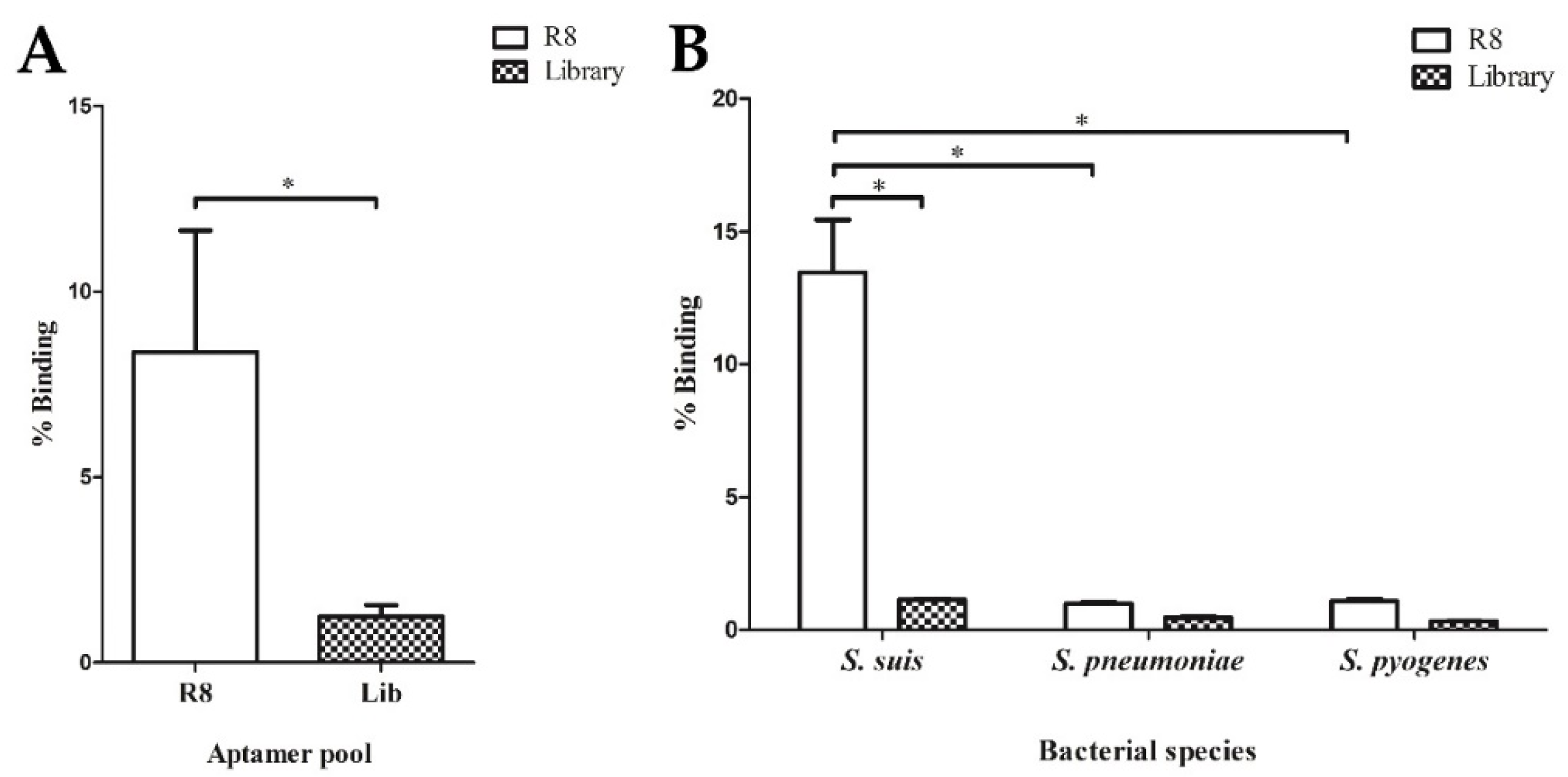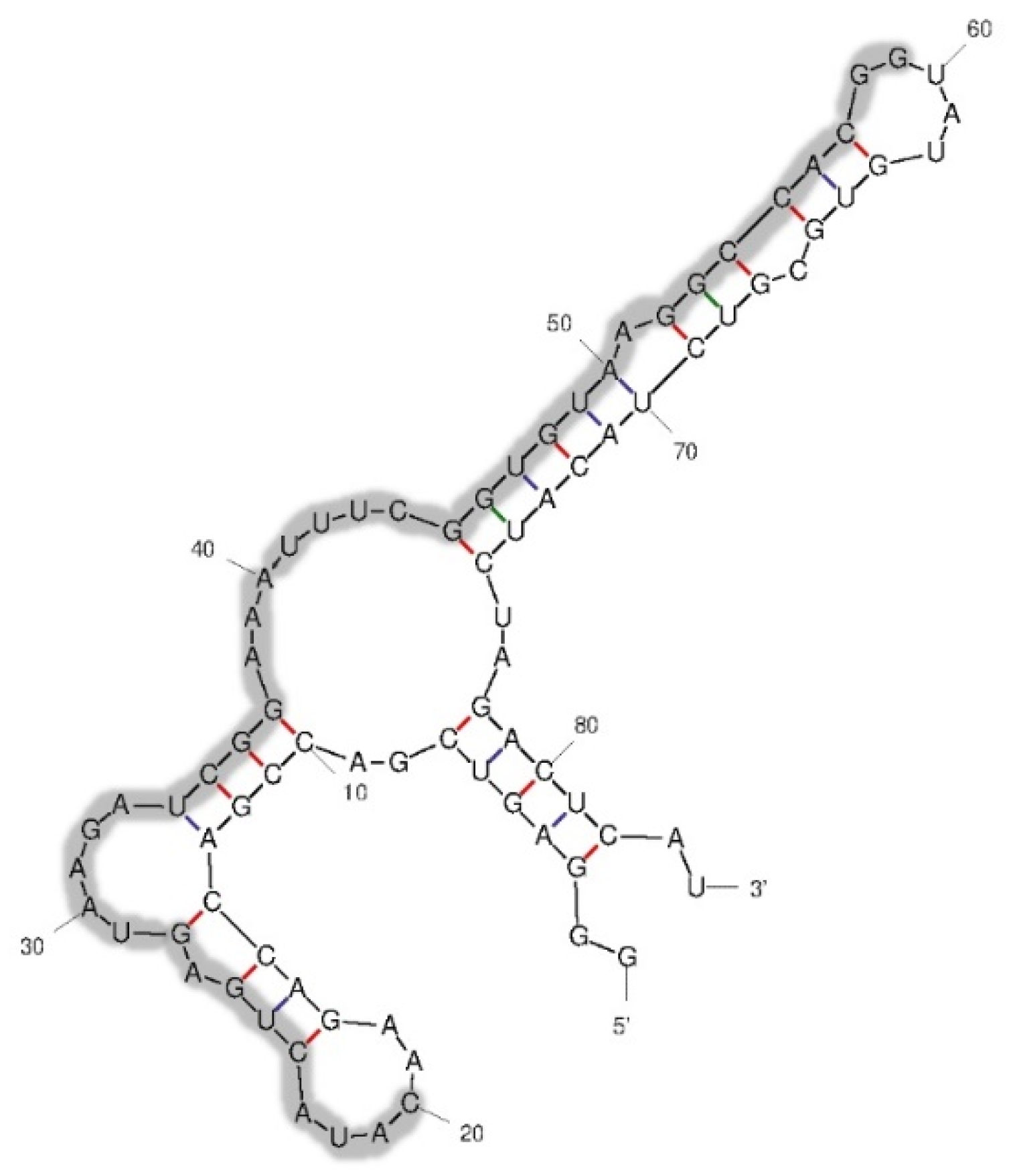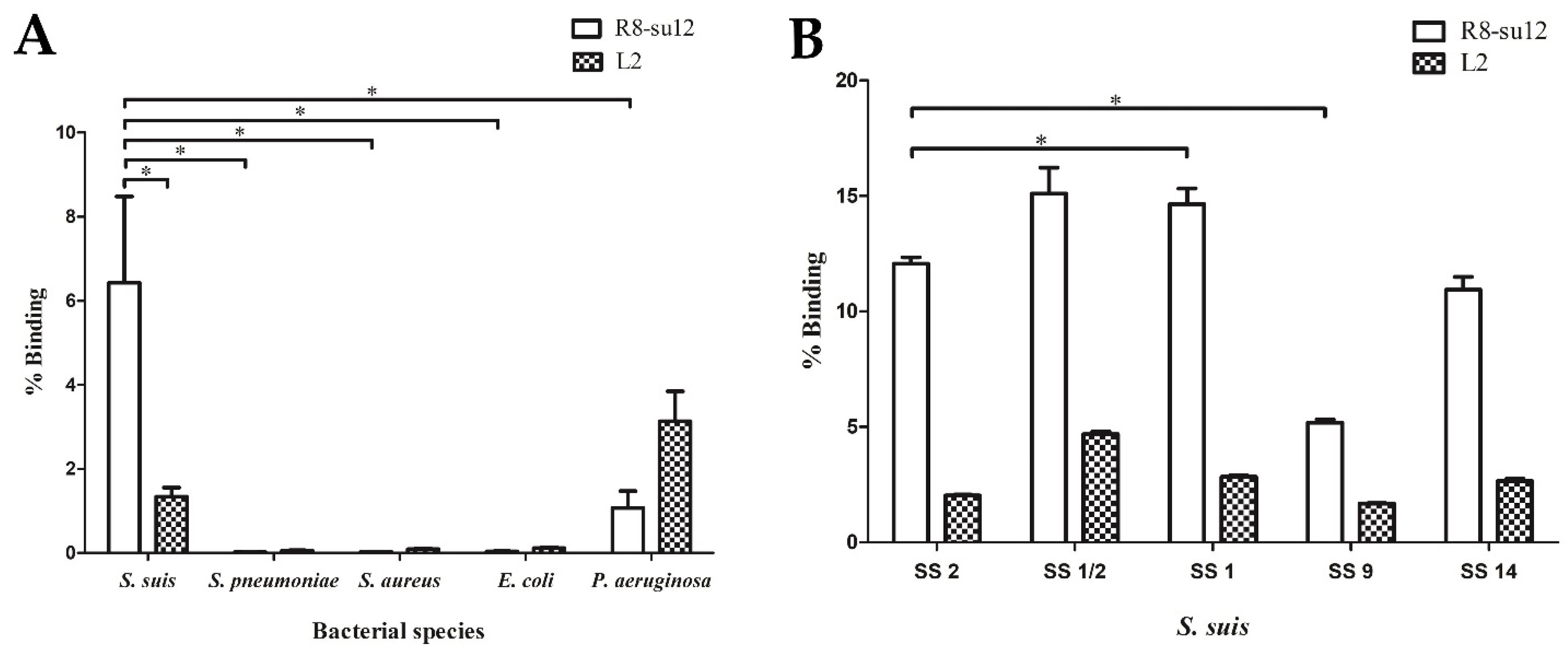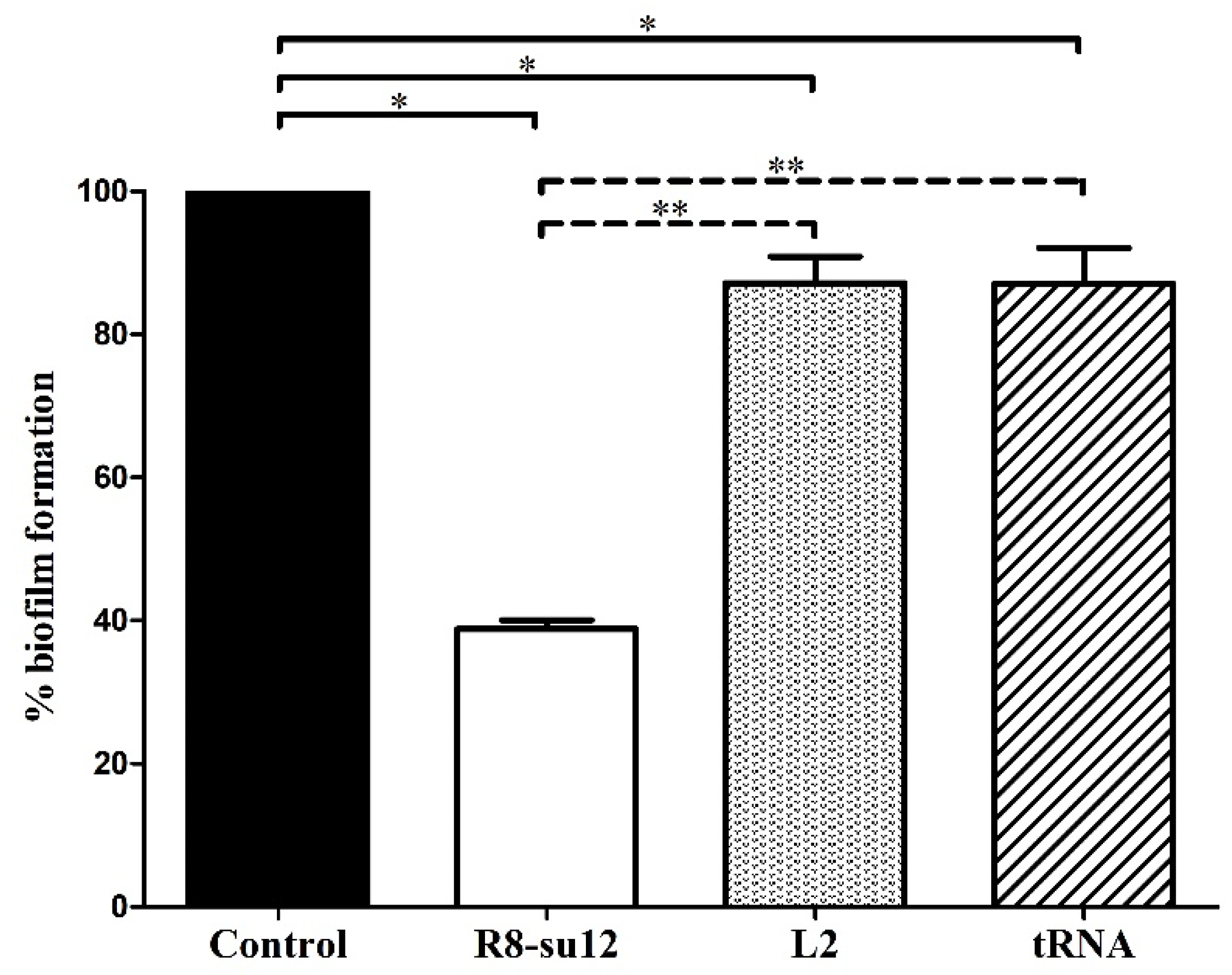The Ability of Nuclease-Resistant RNA Aptamer against Streptococcus suis Serotype 2, Strain P1/7 to Reduce Biofilm Formation In Vitro
Abstract
:1. Introduction
2. Results
2.1. Nuclease-Resistant RNA Aptamer Selection Based on the Cell-SELEX Technique
2.2. Specificity of R8-su12 RNA Aptamer
2.3. The Effect of R8-su12 RNA Aptamer on S. suis SS 2, P1/7 Biofilm Formation
3. Discussion
4. Materials and Methods
4.1. Bacteria Used and Culture Condition
4.2. Cell-SELEX Technique
4.3. Evaluation of Relative Binding Affinity and Specificity of the RNA Aptamer
4.4. Aptamer Characterization
4.5. Biofilm Formation Assay
4.6. Statistically Analysis
5. Conclusions
Supplementary Materials
Author Contributions
Funding
Institutional Review Board Statement
Informed Consent Statement
Data Availability Statement
Acknowledgments
Conflicts of Interest
Sample Availability
References
- Staats, J.J.; Feder, I.; Okwumabua, O.; Chengappa, M.M. Streptococcus Suis: Past and present. Vet. Res. Commun. 1997, 21, 381–407. [Google Scholar] [CrossRef] [PubMed]
- Tang, J.; Wang, C.; Feng, Y.; Yang, W.; Song, H.; Chen, Z.; Yu, H.; Pan, X.; Zhou, X.; Wang, H.; et al. Streptococcal toxic shock syndrome caused by Streptococcus suis serotype 2. PLoS Med. 2006, 3, e151. [Google Scholar] [CrossRef] [PubMed] [Green Version]
- Okura, M.; Osaki, M.; Nomoto, R.; Arai, S.; Osawa, R.; Sekizaki, T.; Takamatsu, D. Current taxonomical situation of Streptococcus suis. Pathogens 2016, 5, 45. [Google Scholar] [CrossRef] [Green Version]
- Dutkiewicz, J.; Sroka, J.; Zając, V.; Wasiński, B.; Cisak, E.; Sawczyn, A.; Kloc, A.; Wójcik-Fatla, A. Streptococcus suis: A re-emerging pathogen associated with occupational exposure to pigs or pork products. part I—epidemiology. Ann. Agric. Environ. Med. 2017, 24, 683–695. [Google Scholar] [CrossRef] [PubMed]
- Wangkaew, S.; Chaiwarith, R.; Tharavichitkul, P.; Supparatpinyo, K. Streptococcus suis infection: A series of 41 cases from Chiang Mai University Hospital. J. Infect. 2006, 52, 455–460. [Google Scholar] [CrossRef]
- Kerdsin, A.; Dejsirilert, S.; Puangpatra, P.; Sripakdee, S.; Chumla, K.; Boonkerd, N.; Polwichai, P.; Tanimura, S.; Takeuchi, D.; Nakayama, T.; et al. Genotypic profile of Streptococcus suis serotype 2 and clinical features of infection in humans, Thailand. Emerg. Infect. Dis. 2011, 17, 835–842. [Google Scholar] [CrossRef]
- Hommez, J.; Devriese, L.A.; Henrichsen, J.; Castryck, F. Identification and characterization of Streptococcus suis. Vet. Microbiol. 1986, 11, 349–355. [Google Scholar] [CrossRef]
- Goyette-Desjardins, G.; Auger, J.P.; Xu, J.; Segura, M.; Gottschalk, M. Streptococcus suis, an important pig pathogen and emerging zoonotic agent—An update on the worldwide distribution based on serotyping and sequence typing. Emerg. Microbes. Infect. 2014, 3, e45. [Google Scholar] [CrossRef]
- Van Calsteren, M.R.; Gagnon, F.; Lacouture, S.; Fittipaldi, N.; Gottschalk, M. Structure determination of Streptococcus suis serotype 2 capsular polysaccharide. Biochem. Cell. Biol. 2010, 88, 513–525. [Google Scholar] [CrossRef]
- Donlan, R.M.; Costerton, J.W. Biofilms: Survival mechanisms of clinically relevant microorganisms. Clin. Microbiol. Rev. 2002, 15, 167–193. [Google Scholar] [CrossRef] [Green Version]
- Grenier, D.; Grignon, L.; Gottschalk, M. Characterisation of biofilm formation by a Streptococcus suis meningitis isolate. Vet. J. 2009, 179, 292–295. [Google Scholar] [CrossRef] [PubMed]
- Stoltenburg, R.; Reinemann, C.; Strehlitz, B. SELEX—A (r)evolutionary method to generate high-affinity nucleic acid ligands. Biomol. Eng. 2007, 24, 381–403. [Google Scholar] [CrossRef] [PubMed]
- Ellington, A.D.; Szostak, J.W. In vitro selection of RNA molecules that bind specific ligands. Nature 1990, 346, 818–822. [Google Scholar] [CrossRef] [PubMed]
- Tuerk, C.; Gold, L. Systematic evolution of ligands by exponential enrichment: RNA ligands to bacteriophage T4 DNA polymerase. Science 1990, 249, 505–510. [Google Scholar] [CrossRef] [PubMed]
- Darmostuk, M.; Rimpelova, S.; Gbelcova, H.; Ruml, T. Current approaches in SELEX: An update to aptamer selection technology. Biotechnol. Adv. 2015, 33, 1141–1161. [Google Scholar] [CrossRef]
- Shigdar, S.; Macdonald, J.; O’Connor, M.; Wang, T.; Xiang, D.; Al Shamaileh, H.; Qiao, L.; Wei, M.; Zhou, S.F.; Zhu, Y. Aptamers as theranostic agents: Modifications, serum stability and functionalisation. Sensors 2013, 13, 13624–13637. [Google Scholar] [CrossRef] [Green Version]
- Sampson, T. Aptamers and SELEX: The technology. World Pat. Inf. 2003, 25, 123–129. [Google Scholar] [CrossRef]
- Thongkamkoon, P.; Kiatyingangsulee, T.; Gottschalk, M. Serotypes of Streptococcus suis isolated from healthy pigs in Phayao Province, Thailand. BMC Res. Notes 2017, 10, 53. [Google Scholar] [CrossRef] [Green Version]
- Wang, Y.; Wang, Y.; Sun, L.; Grenier, D.; Yi, L. Streptococcus suis biofilm: Regulation, drug-resistance mechanisms, and disinfection strategies. Appl. Microbiol. Biotechnol. 2018, 102, 9121–9129. [Google Scholar] [CrossRef]
- Eaton, B.E.; Pieken, W.A. Ribonucleosides and RNA. Annu. Rev. Biochem. 1995, 64, 837–863. [Google Scholar] [CrossRef]
- Pieken, W.; Tasset, D.; Janjic, N.; Gold, L.; Kirschenheuter, G.P.; (Inventors); Gilead Sciences Inc.; (Assignee). High Affinity Nucleic Acid Ligand Containing Modified Nucleotides. U.S. Patent US5660985A, 26 August 1997. Available online: https://patents.google.com/patent/US6184364B1/en (accessed on 9 December 2021).
- Polisky, B.; Jenison, R.D.; Gold, L.; (Inventors); Gilead Sciences Inc.; (Assignee). High-Affinity Nucleic Acid Ligands That Discriminate between Theophylline and Caffeine. U.S. Patent US5580737A, 3 December 1996. Available online: https://patents.google.com/patent/US5580737A/en (accessed on 9 December 2021).
- Baums, C.G.; Valentin-Weigand, P. Surface-associated and secreted factors of Streptococcus suis in epidemiology, pathogenesis and vaccine development. Anim. Health Res. Rev. 2009, 10, 65–83. [Google Scholar] [CrossRef] [PubMed]
- Nosaz, Z.; Rasoulinejad, S.; Mousavi Gargari, S.L. Development of a DNA aptamer to detect Brucella abortus and Brucella melitensis through cell SELEX. Iran. J. Vet. Res. 2020, 21, 294–300. [Google Scholar] [PubMed]
- Van Calsteren, M.R.; Gagnon, F.; Calzas, C.; Goyette-Desjardins, G.; Okura, M.; Takamatsu, D.; Gottschalk, M.; Segura, M. Structure determination of Streptococcus suis serotype 14 capsular polysaccharide. Biochem. Cell. Biol. 2013, 91, 49–58. [Google Scholar] [CrossRef] [PubMed]
- Van Calsteren, M.R.; Goyette-Desjardins, G.; Gagnon, F.; Okura, M.; Takamatsu, D.; Roy, R.; Gottschalk, M.; Segura, M. Explaining the Serological Characteristics of Streptococcus suis Serotypes 1 and 1/2 from Their Capsular Polysaccharide Structure and Biosynthesis. J. Biol. Chem. 2016, 291, 8387–8398. [Google Scholar] [CrossRef] [Green Version]
- Zhou, Y.; Yu, F.; Chen, M.; Zhang, Y.; Qu, Q.; Wei, Y.; Xie, C.; Wu, T.; Liu, Y.; Zhang, Z.; et al. Tylosin Inhibits Streptococcus suis Biofilm Formation by Interacting With the O-acetylserine (thiol)-lyase B CysM. Front. Vet. Sci. 2022, 8, 829899. [Google Scholar] [CrossRef]
- Meng, X.; Shi, Y.; Ji, W.; Meng, X.; Zhang, J.; Wang, H.; Lu, C.; Sun, J.; Yan, Y. Application of a bacteriophage lysin to disrupt biofilms formed by the animal pathogen Streptococcus suis. Appl. Environ. Microbiol. 2011, 77, 8272–8279. [Google Scholar] [CrossRef] [Green Version]




| Group | Representative Clone | Consensus Randomized Sequences | Nucleotides | Frequency (%) |
|---|---|---|---|---|
| 1 | R8-su12 | CAUACUGAGUAAGAUCGGAAAUUUCGGUGUAAGGCCACGG | 40 | 7/26 (26.9%) |
| 2 | R8-su057 | UGGAUGUAUGGAACUUGCAGAUCUUAACUGCACGAAGCGU | 40 | 2/26 (7.7%) |
| 3 | R8-su15 | ACACGUUGCUGAAACAUACCGAGUAACAUAAAGCGGGUG | 39 | 4/26 (15.4%) |
| 4 | Ungrouped | Different clones with various sequences | 40 | 13/26 (50%) |
| SELEX Round | Input RNA (pmol) | S. suis SS 2, P1/7 (Cells) | Washing |
|---|---|---|---|
| 1 | 100 | 1.03 × 107 | 100 µL × 5 times, 1 min each |
| 2 | 50 | 1.02 × 107 | 100 µL × 5 times, 1 min each |
| 3 | 50 | 1.00 × 107 | 100 µL × 5 times, 3 min each |
| 4 | 25 | 1.11 × 107 | 100 µL × 5 times, 3 min each |
| 5 | 10 | 1.21 × 107 | 100 µL × 5 times, 3 min each |
| 6 | 10 | 1.29 × 107 | 100 µL × 5 times, 5 min each |
| 7 | 10 | 1.01 × 107 | 100 µL for 1 min, followed by electrophoretic separation |
| 8 | 10 | 1.07 × 107 | 100 µL for 1 min, followed by electrophoretic separation |
Publisher’s Note: MDPI stays neutral with regard to jurisdictional claims in published maps and institutional affiliations. |
© 2022 by the authors. Licensee MDPI, Basel, Switzerland. This article is an open access article distributed under the terms and conditions of the Creative Commons Attribution (CC BY) license (https://creativecommons.org/licenses/by/4.0/).
Share and Cite
Matchawong, A.; Srisawat, C.; Sangboonruang, S.; Tharinjaroen, C.S. The Ability of Nuclease-Resistant RNA Aptamer against Streptococcus suis Serotype 2, Strain P1/7 to Reduce Biofilm Formation In Vitro. Molecules 2022, 27, 3894. https://doi.org/10.3390/molecules27123894
Matchawong A, Srisawat C, Sangboonruang S, Tharinjaroen CS. The Ability of Nuclease-Resistant RNA Aptamer against Streptococcus suis Serotype 2, Strain P1/7 to Reduce Biofilm Formation In Vitro. Molecules. 2022; 27(12):3894. https://doi.org/10.3390/molecules27123894
Chicago/Turabian StyleMatchawong, Apinyapat, Chatchawan Srisawat, Sirikwan Sangboonruang, and Chayada Sitthidet Tharinjaroen. 2022. "The Ability of Nuclease-Resistant RNA Aptamer against Streptococcus suis Serotype 2, Strain P1/7 to Reduce Biofilm Formation In Vitro" Molecules 27, no. 12: 3894. https://doi.org/10.3390/molecules27123894
APA StyleMatchawong, A., Srisawat, C., Sangboonruang, S., & Tharinjaroen, C. S. (2022). The Ability of Nuclease-Resistant RNA Aptamer against Streptococcus suis Serotype 2, Strain P1/7 to Reduce Biofilm Formation In Vitro. Molecules, 27(12), 3894. https://doi.org/10.3390/molecules27123894








